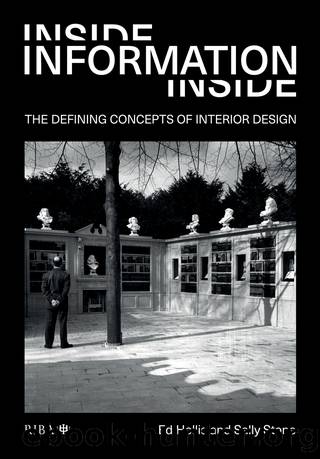Inside Information by Stone Sally;Hollis Edward; & Sally Stone

Author:Stone, Sally;Hollis, Edward; & Sally Stone [Stone, Sally;Hollis, Edward; & Stone, Sally]
Language: eng
Format: epub
ISBN: 9781003277835
Publisher: RIBA Publications
Published: 2022-09-15T00:00:00+00:00
Enfilade
Prior to 1650, there was no distinction between the way through a house and the inhabited spaces within it. Doorways were usually placed centrally in adjoining walls to allow occupants the freedom to travel unhindered from room to room, and so the house was âa complex matrix of discrete but thoroughly interconnected chambers'.119 Within grand houses, appearance was considered to be much more important than privacy, and architects prided themselves on aligning all the doors enfilade so there was an unobstructed view from one end of the house to another. Everyone passed through these openings: the owners, the guests and the servants traversed every room to get to the next.
Kimberley Hall in Norfolk was constructed on the cusp of the change from room-to-room circulation to the use of corridors, and as a result it is in the strange position of containing both. William Talman built the stately home at the beginning of the 18th century for the Wodehouse family - cousins of the author P.G. Wodehouse - and according to the Quarterly Journal of the Wodehouse Society it really was once occupied by a Sir Bertram of Wodehouse.120 The huge orthogonal redbrick house has a corridor running horizontally through the centre of the building, linking a staircase at each end and effectively dividing the back from the front. Across the front of the house is a full enfilade of rooms, which in effect replicate the central corridor axis. This dual system would certainly allow the servants to be separated from those that they served while also providing means of escape, secret shortcuts and convoluted personal routes through the building, (cf. x-axis)
The French hôtel (ct Yard) is a highly specific building type; an aristocratic residence constructed between c.1550
Fig 15.3 Kimberley Hall, William Talman, 1695, Norfolk: the floor plans show the interconnected enfilade of rooms plus the central corridor on each floor.
and 1800, which today would be called a mansion. These homes of the very rich adopted a particular organisation that adapted itself to the unruly urban pattern that had evolved over hundreds of years within the city of Paris.121 Despite this asymmetry, the buildings each contained a collection of very regular chambers and spaces which were used as the primary salons, while other rooms were deformed or walls thickened to accommodate the lack of orderliness of the overall ground plan. This ingenious approach to composition meant that from the outside the building appeared to be symmetrical, and from any of the principal rooms it also had the appearance of proportion and balance, but the spaces between these primary areas were odd and uneven to accommodate this.
The Hôtel Salé is just such a building. Jean Boullier de Bourges constructed it in the 1650s for Pierre Aubert, seigneur de Fontenay, who had become wealthy through a highly advantageous marriage combined with his role as an adviser to the king. He established his position by raising the tax on salt, which he then had the privilege to collect. Aubert flaunted this success through the
Download
This site does not store any files on its server. We only index and link to content provided by other sites. Please contact the content providers to delete copyright contents if any and email us, we'll remove relevant links or contents immediately.
Kathy Andrews Collection by Kathy Andrews(10519)
The remains of the day by Kazuo Ishiguro(7551)
Spare by Prince Harry The Duke of Sussex(4195)
Paper Towns by Green John(4169)
The Body: A Guide for Occupants by Bill Bryson(3800)
Be in a Treehouse by Pete Nelson(3212)
Harry Potter and the Goblet Of Fire by J.K. Rowling(3043)
Goodbye Paradise(2962)
Never by Ken Follett(2880)
Into Thin Air by Jon Krakauer(2701)
The Remains of the Day by Kazuo Ishiguro(2617)
The Genius of Japanese Carpentry by Azby Brown(2609)
The Cellar by Natasha Preston(2595)
Drawing Shortcuts: Developing Quick Drawing Skills Using Today's Technology by Leggitt Jim(2532)
120 Days of Sodom by Marquis de Sade(2436)
Architecture 101 by Nicole Bridge(2350)
The Man Who Died Twice by Richard Osman(2298)
Machine Learning at Scale with H2O by Gregory Keys | David Whiting(2289)
Fairy Tale by Stephen King(2069)
